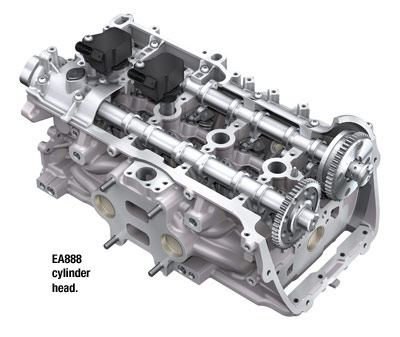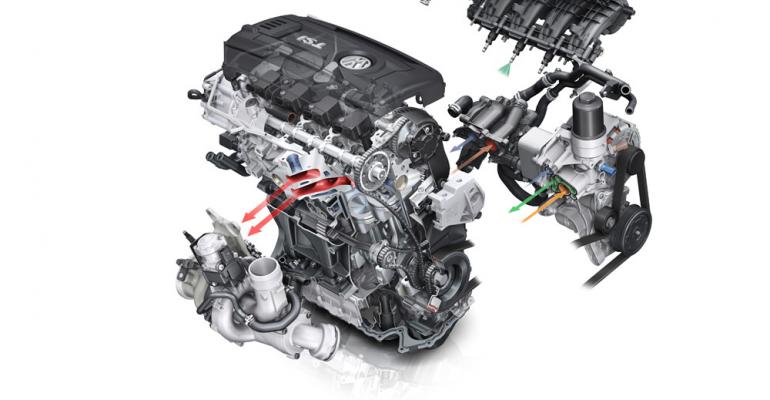ST. HELENA, CA – No need to fear the trend toward shrinking displacements.
Volkswagen nails it with the 1.8L version of its new direct-injected, turbocharged EA888 4-cyl. family, the smaller, lighter-weight engine that is replacing the larger, naturally aspirated 2.5L 5-cyl. throughout much of its U.S. lineup – and outperforms it in every category.
Offered for test drives here for the first time in a number of ’14 cars, the cleverly engineered 1.8L delivers, no matter the model or transmission configuration.
The EA888 family dates back to the original 2.0L TSI (turbocharged, direct-injected) 4-cyl. that bowed in 2006. The more mildly tweaked second generation was rolled out three years later, but the new Gen 3 rendition is a much bigger leap forward, with an innovative 1-piece cylinder head/exhaust manifold, a reduction in weight and power and fuel economy ratings that exceed the outgoing 2.5L widely used in the U.S.
First off, the new 1.8L greatly outshines the 2.5L on paper. It matches the bigger engine’s 170 hp, but its peak at 4,800-6,200 rpm arrives 900 revs sooner. Its 184 lb.-ft. (250 Nm) of peak torque, available at just 1,500 rpm, easily surpasses the 2.5’s 177 lb.-ft. (240 Nm) at 4,250 rpm, and the engine knocks 0.7 seconds off a Jetta’s 0-60 mph (97 km/h) run, now put at 7.3 seconds.
To top it off, fuel economy also is better, rated at 24/35 mpg (9.9-6.7 L/100 km) in the manual-transmission Passat compared with 22/32 mpg (10.7-7.3 L/100 km) for the outgoing 2.5L.
Officials say the engine’s performance is driven by VW’s “down-speeding” philosophy covering all new-engine development, which seeks to deliver peak power at lower engine rpm, optimizing both the acceleration curve and real-world fuel economy at the same time.
Critical is the integrated aluminum head/manifold, which was made possible by the engine’s turbo-only configuration and advances in engineering software over the last four years that enabled VW to simulate exhaust flow simultaneously with component and water temperature, says Douglas Skorupski, technical strategy manager for Volkswagen of America.
 Because thermodynamics were modeled precisely during development, the engine’s thermostat maintains coolant temperature between 185º-225º F (85º-107º C), minimizing friction. Exhaust gases are directed through the water-cooled manifold, meaning they are about 160º F (71º C) cooler by the time they reach the turbo, which includes a new-alloy turbine wheel that can withstand temperatures up to 1,796º F (981º C).
Because thermodynamics were modeled precisely during development, the engine’s thermostat maintains coolant temperature between 185º-225º F (85º-107º C), minimizing friction. Exhaust gases are directed through the water-cooled manifold, meaning they are about 160º F (71º C) cooler by the time they reach the turbo, which includes a new-alloy turbine wheel that can withstand temperatures up to 1,796º F (981º C).
The design, Skorupski says, allows the engine to heat more quickly, getting oil up to operating temperature much faster to cut cold-start emissions and, on cold days, helping to heat the cabin sooner.
Because cooling is optimized, there’s no need to enrich fuel mixture at higher speeds, meaning the VW engine should deliver real-world fuel economy much closer to its government rating. Consumer unrest over the gap between their vehicle’s fuel efficiency and its label rating is a trend “that is starting to get some traction in this market,” Skorupski notes here.
Weight has been cut to 290 lbs. (132 kg) for the 2.0L version of the new engine, down 8 lbs. (4 kg) from its Gen 2 predecessor, in part due to a thinwall casting technique that has reduced the iron block’s wall thickness to as little as 0.12 ins. (3.0 mm).
Sampled here in ’14 Jetta SE models with both the 6-speed automatic transmission and 5-speed manual, as well as a Passat SEL, where it is available only with the automatic, the Gen 3 EA888 performs as well under the hood as on paper.
Tip in the throttle and full torque is delivered without hesitation, even when the 1.8L is mated with the Jetta’s automatic transmission, meaning the numerous uphill climbs along our 28-mile (45-km) circuit through Napa Valley wine country are no match for the new engine.
The EA888 does have to work a little harder – downshifts seem to occur a little sooner and more frequently – with the bigger Passat sedan, which outweighs the Jetta by about 200 lbs. (91 kg). But that’s a minor complaint; the engine is more than adequate, and a little more bluster when being pushed seems a fair tradeoff for a few more miles per gallon in fuel economy.
Still, our favorite among the three vehicles tested is the Jetta SE with the manual gearbox, which allows the driver to wring the most out of the 4-cyl. On the surface, the lack of a sixth forward gear appears to be the one powertrain faux pas, and it might make the car look dated to consumers cross-shopping in the era of the 6- and 7-speed manual.
But truth be told, five speeds may be enough, as the Jetta cruises effortlessly at 60 mph with the engine spinning comfortably at just 1,800 rpm.
At the same time, the direct-injected 1.8L is decidedly civil. Thanks in part to twin balance shafts, there is zero noise and vibration at idle in all three of the cars tested, without expensive active noise-cancellation technologies. And the engine remains quiet at speed, though it will deliver a pleasing baritone grunt when pushed.
NVH is so good, the 1.8L could be stiff competition for inherently louder new diesel engines, including those coming from VW.
All vehicles with 1.8L engines also get a new electric power steering system, which varies somewhat in feel depending on model and trim. The Passat SEL is the least precise among the models tested, with the Jetta SE the most confidence-inspiring. But none tilts too far in the overly assisted direction.
Both the 1.8L 4-cyl. and the 2.0L TSI engine that goes into the Beetle Turbo (which carries the R-Line badging for ’14) are produced at VW’s new Silao, Mexico, plant. The 1.8L will be available as an up option in the Jetta from the base naturally aspirated 2.0L. It will be marketed as an upgrade from the 2.5L in the Passat. Later in the model year, it will replace the 2.5L as the entry engine in the Beetle.
VW’s biggest hurdle may be convincing Internet shoppers comparing Jetta specs against competitors offering entry-level 2.0L engines that its smaller-displacement EA888 is worth a test drive.
The auto maker is concerned enough about the negative perception of downsizing that it is phasing out the practice of badging its vehicles with their engine displacements. The 1.8L cars simply will say TSI on their decklids.
But consumers shouldn’t be fooled into thinking bigger is always better. With the 1.8L, VW has proven downsizing and down-speeding can work quite well, if you engineer-in all the right sweet spots.
| Material | Iron Block/Aluminum Head |
| Valvetrain | DOHC 16-Valve/Variable Intake Timing |
| Power (SAE net) | 170 hp @ 4,800-6,200 rpm |
| Torque | 184 lb.-ft. (250 Nm) @ 1,500 rpm |
| Bore x stroke (mm) | 82.5 x 84.1 |
| Compression ratio | 9.6:1 |
| Transmission | 6-speed automatic/5-speed manual (Jetta) |
| Fuel economy (manual, Jetta) | 26/36 mpg (9.0-6.5 L/100 km) |
| Applications | Jetta, Passat, Beetle |





